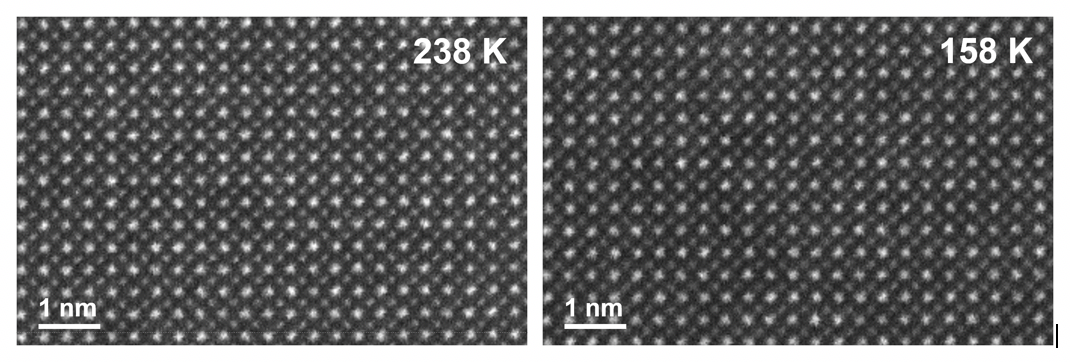Atomic-resolution cryogenic STEM provides a path to probe the microscopic nature of low-temperature phases in quantum materials. To date, successful high-resolution cryo-experiments have been limited to few and fixed temperatures, dictated by the choice of cryogen, leaving most of the phase space of materials unexplored.
 |
|
Figure: HAADF-STEM images of crystalline Bi0.35Sr0.18Ca0.47MnO3 in the CVT cryo-holder at calibrated intermediate temperatures of (left) 238 K and (right) 158 K show sub-Å resolution. |
The novel side-entry continuously variable-temperature (CVT) liquid nitrogen cryo-holder specifically addresses this opportunity: the combination of liquid nitrogen cooling with local MEMS heating at the sample permits temperature control between ~100-1000 K. Additional design considerations include a large-volume cryogen reservoir and active rod temperature compensation to further mitigate many of the challenges of standard cryo-STEM experiments, enabling consistent sub-Å imaging resolution and dramatically decreased drift rates. Our proof-of-concept experiments mark a significant progress for the accessibility of variable-temperature cryo-electron microscopy, opening the doors to a new range of high-resolution in situ cryo-experiments including the real-time observation of phase transitions, temperature cycling, and access to phases which are stable only in narrow temperature windows.
Broadly tunable, controlled-temperature cryo-STEM is now available to all PARADIM users with the new CVT cryo-holder in and only in PARADIM’s Electron Microscopy user facility.
B.H. Goodge et al. Microscopy and Microanalysis 26 (2020) 439 – 446.
Technical Background: As atomic-resolution imaging and spectroscopy of crystalline materials at room temperature has become almost routine, the interest in cryogenic electron microscopy has been renewed. Recent results have demonstrated the potential for cryogenic scanning transmission electron microscopy (STEM) and electron energy loss spectroscopy (EELS) to explore a number of quantum materials phenomena, but atomic-resolution low-temperature experiments reported to date have been limited to single temperatures set by the choice of cryogen, i.e., liquid nitrogen or helium. Richer exploration of many systems requires stable imaging conditions at continuously variable temperatures to tune into phases with narrow stable temperature windows or track phase transitions as they occur.
Side-entry cryo-holders for (S)TEM consist of a long hollow metal rod at one end of which the sample is mounted and held in the microscope column. The sample is thermally coupled through the length of the metal rod to a cryogen cold sink outside of the microscope, usually either a dewar or lines of cryogen. Most high-resolution (S)TEM experiments with such a setup are, however, complicated by 1) thermal contraction of the macroscopic metal rod which can result in dramatic directional drift of the sample and 2) mechanical coupling of the sample to the external environment via the cryogen reserve resulting in vibrations from boiling or bubbling within the cryogen.
Most successful cryo-experiments to date have been performed at cryogen-set temperatures—usually near ~90 K (liquid nitrogen) or ~10 K (liquid or cold gas helium)—in order to preserve a fixed thermal equilibrium. In principle, variable temperature control is possible with some commercial cryo-holders through resistive heating of the sample rod or by regulation of the cryogen flow through the holder or stage. In practice, the spatial resolution obtained at intermediate temperatures has so far been limited. TO this end, Zandbergen, et al. (HennyZ Co.) developed a continuously variable temperature (CVT) liquid nitrogen specimen holder which achieves fine temperature control across the ~100-1000 K range by integrating local heating of the sample via 6-pin MEMS control with liquid nitrogen cooling. In addition to the local MEMS heating, this performance is enabled by active heating of the CVT cryo-holder rod which reduces thermal sample drift. Compared to other commercially available fixed-temperature cryo-holders, our results with the new CVT cryo-holder demonstrate comparable (sub-Å) imaging resolution as well as sample drifts rates (~0.3-0.4 Å/s) reduced by as much as half across the full range of accessible temperatures from ~100-1000 K, illustrating an important technical development for both the microscopy and materials communities.
The new sample holder design was developed by the PARADIM in-house research team at Cornell University together with a collaborator at Delft University of Technology (The Netherlands).
Full reference: B. H. Goodge, E. Bianco, H. W. Zandbergen L. F. Kourkoutis, "Atomic-resolution cryo-STEM across continuously variable temperature," Microscopy and Microanalysis 26 (2020) 439 – 446. https://doi.org/10.1017/S1431927620001427
Return to: In-house Research Highlights







